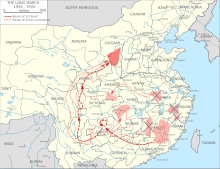
Back Lang mars Afrikaans المسيرة الطويلة Arabic Llarga Marcha AST اۇزون یورویوش AZB Langa Marsch BAR Дългият марш Bulgarian দীর্ঘ অভিযাত্রা Bengali/Bangla Llarga Marxa Catalan Uâng-lī Diòng-cĭng CDO Dlouhý pochod Czech
| Long March | |||||||
|---|---|---|---|---|---|---|---|
| Part of Chinese Civil War | |||||||
 Overview map of the route of the Long March Light red areas show Communist enclaves. Areas marked by a blue "X" were overrun by Kuomintang forces during the Fourth Encirclement Campaign, forcing the Fourth (north) and Second (south) Red Armies to retreat westward (dotted lines). The heavy dashed line is the route of the First Red Army from Jiangxi. The withdrawal of all three Red Armies ends in the northeast enclave of Shaanxi. | |||||||
| |||||||
| Belligerents | |||||||
|
Military assistance: |
Supported by: | ||||||
| Commanders and leaders | |||||||
|
|
| ||||||
| Strength | |||||||
| over 300,000 |
First Front Red Army: 69,000 (October 1934) 7,000 (October 1935) | ||||||
| Long March | |||||||||||||||||||||||
|---|---|---|---|---|---|---|---|---|---|---|---|---|---|---|---|---|---|---|---|---|---|---|---|
| Traditional Chinese | 長征 | ||||||||||||||||||||||
| Simplified Chinese | 长征 | ||||||||||||||||||||||
| |||||||||||||||||||||||
The Long March (Chinese: 长征; pinyin: Chángzhēng; lit. 'Long Expedition') was a military retreat by the Chinese Red Army from advancing Nationalist forces during the Chinese Civil War in 1934 through 1936.
Several Red Army forces took various routes from Chinese Communist Party (CCP) strongholds being encircled by the Kuomintang (KMT) National Revolutionary Army. Their concurrent retreats took more than a year, traversing thousands of kilometers through western and central China to convene at the new Communist base of operations in Yan'an, in the northwestern province of Shaanxi.
The most famous of these marches was undertaken by the First Red Army under the leadership of Mao Zedong. Departing from their headquarters in the southern province of Jiangxi on 16 October 1934, the 65,000-person First Army marched more than 9,000 kilometres (5,600 mi) in a large clockwise arc through the western frontiers of the country, ultimately meeting with other Communist forces in Yan'an on 19 October 1935. The circuitous route brought the First Army through some of the most difficult terrain in the country while pursued by the Nationalists: at first the NRA under Chiang Kai-Shek, and later by local cliques of Nationalist-aligned warlords. Fewer than 8,000 people traveling with the First Red Army survived the march.[1][2]
The Second and Fourth Red Armies would continue to retreat under pressure into the following year, ultimately meeting the First Army in Yan'an on 22 October 1936.
Mao's leadership during the retreat brought him immense prestige and support among many within the otherwise-shattered Communist Party. It marked the beginning of Mao's long ascent to primacy within the CCP, and would be featured heavily in his public image, through the founding of the People's Republic.
Cite error: There are <ref group=lower-alpha> tags or {{efn}} templates on this page, but the references will not show without a {{reflist|group=lower-alpha}} template or {{notelist}} template (see the help page).
- ^ "Long March | Chinese history | Britannica". www.britannica.com. Retrieved 2023-05-16.
- ^ Zhang, Chunhou. Vaughan, C. Edwin. [2002] (2002). Mao Zedong as Poet and Revolutionary Leader: Social and Historical Perspectives. Lexington books. ISBN 0-7391-0406-3. p. 65.
© MMXXIII Rich X Search. We shall prevail. All rights reserved. Rich X Search